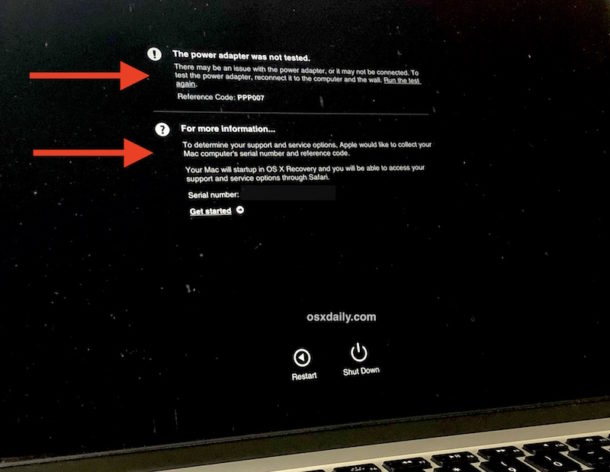Free utility for MacBook, PowerBook and iBook owners that monitors virtual all battery health parameters and displays them in an easy-to-read format. Techtool Pro is feature-packed with benefits that all Mac users need for comprehensive diagnostics, repair, and maintenance.
Most Mac users will experience years of using a Mac without any problems. But every so often, a hardware issue could surface that could significantly impact how your Mac performs.
Identifying the cause of problems — hardware or software — is the first step to fixing them. It could make a trip to an Apple Store or certified reseller easier knowing you've done all you can to identify and whenever possible, fix the problem yourself — saving you downtime and a potentially costly repair.
Built into every Mac is a way to run an Apple Hardware Test, also known as an Apple Diagnostics.
Hardware Tests are an effective way to identify the cause of a Mac performance problem, which could be CPU or GPU issue, a failing disk drive, an overloaded memory, a fan overheating, or any number of other potential faults. If you suspect it’s a hardware problem, Hardware Tests are the way to troubleshoot on Macs built before 2013. In newer models, those built after 2013, those same tests are labelled Apple Diagnostics.


- The Best Free Diagnostic Software app downloads for Mac: Blackmagic Disk Speed Test iStat Menus Net Check WiFi Signal Strength Status iFreeMem SMARTRe.
- On your Mac, choose Apple menu Restart, then press and hold the D key while your Mac restarts. Keep holding the D key until the screen listing different languages appears. Select a language. Apple Diagnostics starts automatically. When Apple Diagnostics is finished, it lists any problems it finds. (The reference code is for use by Apple Support.).
How to Run Apple Diagnostics on any Mac
In some cases, a hardware problem is so severe that you won’t be able to switch your Mac back on. Thankfully, if you can run an Apple Diagnostics or Hardware Test, Apple Support suggests this is a way you can restart your Mac, even if it refuses to switch back on through other means.
Whether you are running an Apple diagnostics (on newer hardware and OS X devices) or a Mac hardware test (on older devices), Apple recommends printing their support instructions on how to run these tests. Once you’ve got the instructions in front of you, Apple recommends going through the following process to diagnose a hardware problem:
- For those with iMacs or any desktop-based device: Disconnect all external drives and hardware devices, except for the keyboard, mouse, display, and speakers.
- Select Apple Menu > Restart.
- Press and hold the D key when the Mac is restarting.
- Apple Diagnostics will run automatically. When it is complete, it will present a list of the problems encountered.
Common Mac Hardware Issues
At this point, you can either follow on-screen instructions or contact Apple Support — arranging a Genius Bar appointment — or go to an Apple Authorized Service Provider to make repairs, to fix the problems. Make a note of any reference codes.
Some of the most common hardware error codes indicate problems with:
- Wi-Fi — a failure of the AirPort wireless card (4AIR);
- Hard disk and SSD (4HDD)
- Logic board (4IRP)
- Memory — RAM (4MEM)
- External disk (4MHD)
- Fans (4MOT)
- Processor (4PRC)
- Video/graphics card (4YDC)
Most Mac error codes suggest a failure of the component they reference, or a related component that is causing a problem with the hardware. In most cases, an Apple specialist or technician may be needed to resolve this issue.
However, before you send your poor, unhealthy Mac off to the shop, there are several fixes you could try at home, such as resetting the PRAM or SMC. This can fix some of the most common errors, including problems with the logic board and fan.
Disk Utility (built-into every OS X) is useful for fixing memory (RAM), hard disk and external drive problems, as are several third-party apps.
For those with older Macs, when you are running an OS X Hardware Test, an alert message will appear once complete with a list of the problems encountered. Again, you have the option of following on-screen instructions to restore the Mac, or re-booting the device using a startup disk, or taking the Mac to a store or Authorized Service Provider.
In any scenario involving hardware, you need to be aware that you are at risk of losing any items on your Mac that haven't been backed-up to the cloud. We recommend storing as much as you can with a cloud provider, such as Dropbox, or Apple iCloud.
Another way to improve Mac performance
What happens if you run a Mac diagnostics and it comes back with nothing? Does this mean you need to buy a new Mac? Or give up using Mac altogether, switching to another device and operating system?
An Apple Diagnostics or Hardware Test that reports a lack of problems indicates it could be a software issue. Another alternative worth exploring, especially if your Mac is overheating or slowing down, is that your storage is too full of junk, clutter, applications, and duplicate files and photos.
On average, Mac users have 62GB of data, files, apps, and images they do not need. Too many files slow down and overheat computers, making them difficult to use and causing them to crash more often.
CleanMyMac X is designed to clear up junk, clutter and get your Mac back to peak performance. With over 4 million downloads and hundreds of positive reviews, we know that CleanMyMac X has carefully removed over 11 million unnecessary apps and over 2.5 billion gigabytes of data clogging up Macs all over the world.
With two click removals, you can quickly clean loads of data, making your Mac easier to use and freeing up space for new documents, downloads and images. Once you've run a Hardware Test or Apple Diagnostics, use CleanMyMac X (it's free to try) to identify and fix any other issues that are causing your Mac to run slowly or overheat.
We hope this article was helpful and you found the answers to all your questions here. Stay tuned!
These might also interest you:
The users trust Mac machines for its performance, reliability, speed, and quality. But when they start to underperform or give issues, we get annoyed. To resolve the problem, we either update the operating system, apps, and other installed programs or take it to the nearest store, right?
We do this out of habit because in general, most errors are tracked to unstable software. But do you know faulty hardware can also cause these issues?
To know if it is the faulty hardware, let’s run Apple Hardware Test, also known as Apple Diagnostics.
What is Apple Diagnostics?
Built-in Mac since 2013 Apple Diagnostics or Apple Hardware Test are the tools designed to diagnose problems with your computer’s internal hardware. These tests are an effective way to identify the cause of a Mac performance problem. This could be a failing disk drive, CPU, GPU, or overloaded memory.
How to Run Apple Diagnostics on Mac?
Sometimes due to hardware problems, the Mac system fails to boot. Luckily, we have Apple Diagnostics or Hardware Test, to resolve this problem. Using them, we can restart Mac.
Note: Before running Apple diagnostics, Apple recommends printing the support instructions. Once you’ve them, you can follow the steps below to run Apple diagnostics (on newer hardware & OS) and Apple Hardware Test (on older devices)
Steps to Run Apple Diagnostics on Mac
Note: Before running Apple Diagnostic disconnect all peripherals, external drives, and hardware devices excluding monitor, keyboard, and mouse.
1. Click the Apple logo and select Restart.
2. Press and hold D key until you see list of different languages on the screen
3. Choose the language; this will run Apple Diagnostics automatically.
4. Wait for 2-5 minutes to get the list of detected problems.
5. You’ll see solutions and error codes.
6. Once you have all the information, you can either repeat the test to get more details or can restart the Mac.
What if you are unable to run diagnostics?
Push Diagnostics For Mac
If Apple Diagnostics fails to run on your Mac, don’t panic. This is not an unsolvable problem. There’s a possibility that some external device is still attached. So, double-check everything and disconnect CD, USB leaving display, keyboard, mouse intact.
Besides, this part of the diagnostics can be damaged. To resolve this restart Mac by holding down Option + D. If this too doesn’t work, then firmware password can be a problem. Make sure you disable it.
Once you keep these points in mind, you will be able to run Apple diagnostics.
What if Apple Diagnostics founds no issues?
Say, for example, you run the diagnostics, and it comes back with nothing? Does it mean everything is fine? Or things are in such bad shape that you will need to buy a new Mac?
Don’t worry; it’s nothing like that. If Apple diagnostics show nothing, it means the hardware is in perfect condition, and the problem might be with the software. Therefore, you need to check if your Mac is overheating or slowing down too much. If that is the case your Mac might be running low on disk space, there might be a lot of junk files or too many duplicates.
All this not only takes up storage space but also slows down Mac, making it difficult for you to work.
In such a case using a best Mac optimizer and cleaner that can clear junk files, declutter Mac, organize data and boost performance is needed. With over 3+ million downloads and several positive reviews, TuneUpMyMac is the right tool for this task. Using this efficient and robust Mac Cleaner, you can quickly recover gigabytes of storage space occupied by unwanted data.

Here’s how TuneUpMyMac works:
1. Download and install TuneUpMyMac
2. Click Start System Scan from the home page
3. Wait for the scan to finish. You will now be able to see detected errors on your system.

4. Click the name of each area to see details about the detected errors
5. When satisfied with the result, click Clean Now.
6. However, if you want to scan and clean each section individually, you can select the modules from the left pane.
7. Once you have the scan results, click Clean Now to fix all the detected errors. By clicking Duplicate Finder, you can scan Mac for all types of duplicates and click them in a single click.
Yay! All the detected errors are removed, and now your Mac will perform better. This means you will see a speed and performance boost.
With just a click or two, you can declutter your Mac and boost system performance. After running the Apple Hardware Test, you know there’s nothing wrong with the hardware. So, to fix software related issues, try using TuneUpMyMac and fix heating, space, and other issues that you often face on Mac.
Mac Network Diagnostic Tool

Diagnostics Machine For Sale
We hope this article was helpful, and you were able to find answers to all your questions. Stay tuned for more such information.
